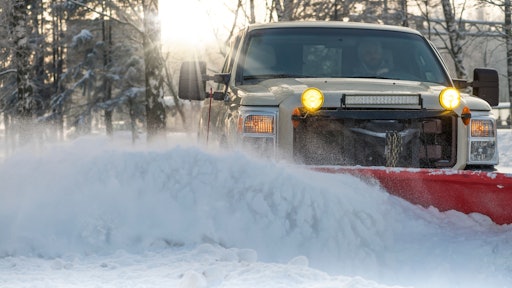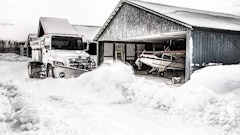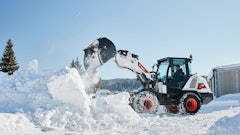
Mother Nature sure likes to throw her curveballs. In places like Minnesota, this winter has brought above-average temps and only a trace of the white stuff so far this year. Other areas of the country are seeing record snowfall. Whether you’re a snow pro or it’s your first season behind the plow, here are a few tips to help you select, operate and maintain your plow for optimal efficiency.
1. Select the right snowplow
There are several things to consider when selecting the right snowplow for your fleet.
First, how do you want to disperse the snow? For simply pushing the snow to the side or piling it into windrows for later removal, a straight blade or V-blade plow provides the best ROI. This type of plow is great for work along roadways, driveways or sidewalks.
If you’re looking for a different dispersal pattern, however, you’ll want to consider a snow pusher—that pushes the snow straight ahead, or a snow blower that throws the snow away from the work area—which we won’t be going into in this article.
Regardless of what type of attachment or implement you choose, your first concern should always be durability and heavy-duty construction. A hardened steel cutting edge is a must-have if you’re looking for the best ROI since this offers the longest lifespan for your equipment. An adjustable spring-loaded blade trip, which protects your attachment and equipment from snow-covered obstacles and pavement edges, should also be on your checklist. We recommend blade guide markers, as well, for better visibility and precision when clearing snow. For convenience, you should also consider flat face couplers that can connect under pressure, and nylon covered hoses.
 Ignite Attachments
Ignite Attachments
Some manufacturers offer these premium features standard, so it might benefit your bottom line to check with more than one brand.
When it comes to spec’ing a plow for a particular carrier, here are some things to keep in mind:
- Know your carrier limitations, including operating and lifting capacity.
- Look for a blade that is wider than your carrier when fully angled.
2. Maximize your plowing efficiency
Once you get to the jobsite, you’ll want to assess any obstacles that might be hidden under the snow such as curbs, manhole covers and other immovable objects since hitting these hidden objects can injure the operator as well as damage your machine and attachment.
Plan your movements to minimize the number of passes you’ll need to make to keep your team efficient. Coordinate with your team to avoid unnecessary downtime and make sure to keep in communication in case the situation changes.
It’s also a good idea to adjust your skid shoes to fit the job at hand. These are designed to protect the surface under the snow. If the area you are working on is gravel, we recommend setting the skid shoes a little below the cutting edge. This allows the plow to float better over the surface without disturbing it.
3. Proper maintenance and storage
Like any attachment, proper care and maintenance of your snowplow after use ensures the best ROI. Even if your model comes with corrosive-resistant coatings, it’s important to hose down equipment once the job is done. While salt and other de-icing solutions might not corrode your blade right away, there are other parts of the snowplow that aren’t as protected, such as hinge points and springs. Spraying off equipment helps minimize the potential for rust.
After cleaning, be sure to grease the zerks and other moving parts. This helps push moisture out of these areas for a longer useful life. Double check that your hoses and fittings are tight at this time.
When storing your snowplow outdoors, we recommend setting it on blocks. This will prevent it from freezing to the ground. It’s best to cover the plow if you can. If not, at least make sure to keep couplers protected and out of the snow.
Let it snow
Predicting seasonal work, like snow removal, might be more challenging these days, but proper selection and maintenance of your snow tools will always deliver optimal ROI. Work with your dealer or equipment manufacturer to ensure you’re ready for winter—whenever it decides to show up.


























